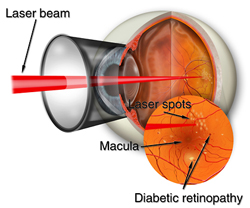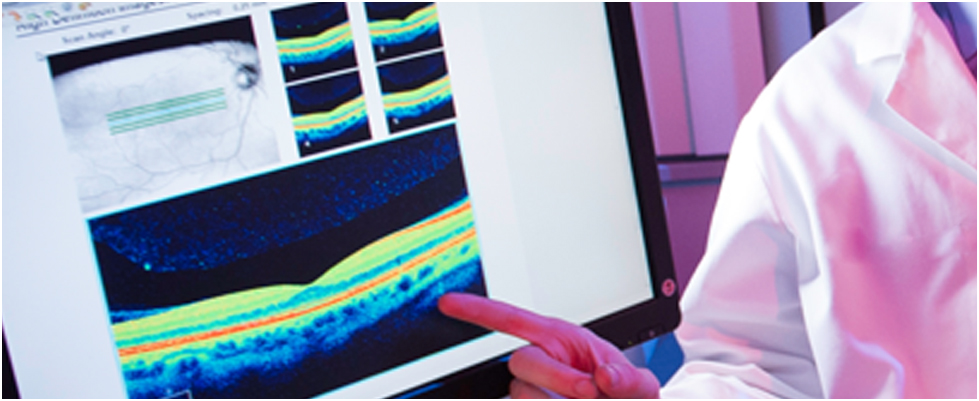With early detection, diagnosis, and treatment we can help prevent or slow vision loss from diabetic retinopathy. Depending on the stage of diabetic retinopathy, the likelihood of progression and amount of vision loss, it is possible to treat, stabilize and often reverse the effects of the disease. The treatment options for diabetic retinopathy can include the use retinal laser photocoagulation treatment as well as intravitreal injections of Vascular Endothelial Growth Factor (VEGF) Inhibitor drugs such as Lucentis® or Eylea® or even other drugs. However, successful management of diabetic eye problems requires early diagnosis and treatment.
The National Institutes of Health and the National Eye Institute have funded a number of large scale, multi-center, controlled studies that have produced clinical care guidelines for Diabetic Retinopathy that are used by the Baltimore Washington Eye Center physicians and Retinal Specialists.
These include:
- Early Treatment Diabetic Retinopathy Study (ETDRS)
- Diabetes Control and Complications Trial (DCCT)
- Diabetic Retinopathy Study (DRS)
- Diabetic Retinopathy Vitrectomy Study (DRVS)
These clinical studies have given us treatment guidelines and protocols to help determine which patients may benefit from various treatment options to delay vision loss and preserve vision. With this information we can guide patients in the treatment of diabetic retinopathy since with early treatment it is possible for patients with diabetic retinopathy to have only half the likelihood of losing vision as compared to those patients who fail to receive early treatment.
About Diabetic Laser Treatment
Laser Treatment for Nonproliferative Retinopathy:
During the early stages of Mild Nonproliferative Retinopathy, Moderate Nonproliferative Retinopathy and the beginning of Severe Nonproliferative Retinopathy, it is not likely that you will need Laser Treatment, unless you have Diabetic Macular Edema.
Laser Treatment for Proliferative Retinopathy:
 Proliferative Retinopathy is treated with a retinal laser photocoagulation procedure called “Scatter Laser Treatment” or Pan Retinal Photocoagulation (PRP). The goal of Scatter Laser Treatment is to shrink abnormal blood vessels. We will place approximately 1,000 to 2,000 laser spots in areas of the retina away from the macula, causing the abnormal blood vessels to shrink. Since Scatter Laser Treatment requires a large number of laser spots, it is often necessary to use two or more sessions to complete the laser treatment.
Proliferative Retinopathy is treated with a retinal laser photocoagulation procedure called “Scatter Laser Treatment” or Pan Retinal Photocoagulation (PRP). The goal of Scatter Laser Treatment is to shrink abnormal blood vessels. We will place approximately 1,000 to 2,000 laser spots in areas of the retina away from the macula, causing the abnormal blood vessels to shrink. Since Scatter Laser Treatment requires a large number of laser spots, it is often necessary to use two or more sessions to complete the laser treatment.
Sometimes patients who have had Scatter Laser Photocoagulation will experience some loss of their side or peripheral vision, some loss of night vision and a decrease in color vision. However, Scatter Laser Treatment is necessary to preserve the rest of your vision and stop the progression of the disease.
We may also discuss the use of intravitreal injections of Vascular Endothelial Growth Factor (VEGF) inhibitors such as Lucentis® or Eylea®, as recent studies have shown them to be of benefit.
When PRP and intravitreal injection are unsuccessful in stopping the progression of the proliferative retinopathy or when a vitreous hemorrhage occurs and does not clear on its own, or when a retinal detachment develops, then a Vitrectomy is often helpful. A vitrectomy involves inserting instruments into the eye, and removing the vitreous gel, any blood present in the vitreous cavity, and removing the scar tissue that has grown on the surface of the retina.
Laser Treatment & Injections for Diabetic Macular Edema
Diabetic Macular Edema was traditionally treated with one of two types of Retinal Laser Photocoagulation procedures: “Focal Laser Treatment” and “Grid Laser Treatment”. Focal Laser treatment is used to close leaking microaneurysms in a limited area and Grid Laser treatment is used to treat a more diffuse swelling in the Macula.
Laser treatment of Diabetic Macular Edema works to stabilize vision. In fact, laser treatment may reduce the risk of vision loss by 50 percent. In a small number of cases, if vision is lost, it may be improved. It is important to restate that this treatment is performed to keep vision from further declining, but does not usually result in improvement in vision already lost.
Today, for most patients, VEGF inhibitor intravitreal injections such as Lucentis® or Eylea®, which are less destructive and safer than laser treatments, are considered as primary therapy for the management of vision-threatening complications of diabetic retinopathy such as diabetic macular edema (DME).
If you or someone you know has diabetes or would like to learn more about treatment of diabetic retinopathy with laser treatment or VEGF injections such as Lucentis® or Eylea®, or needs an appointment for a diabetic eye exam, please call Baltimore Washington Eye Center at 800-495-3937 to schedule an appointment.


